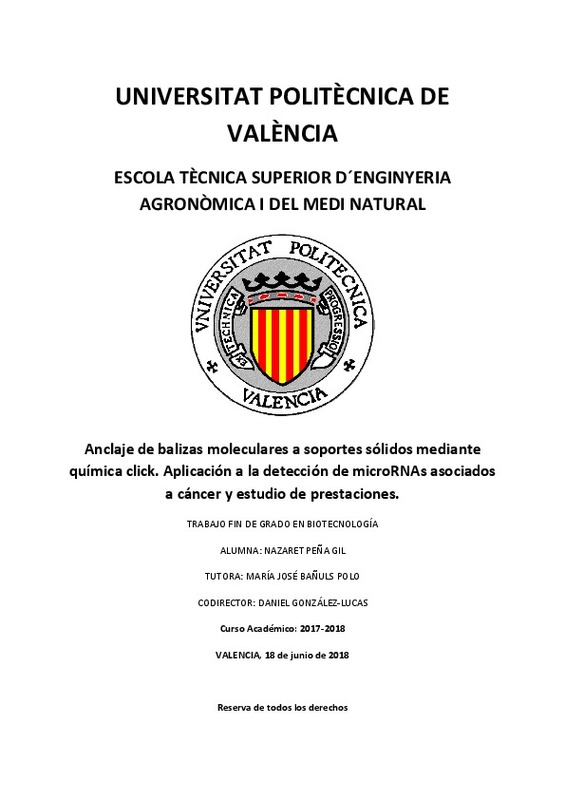|
Resumen:
|
[EN] This work has been carried out within the framework of the European project SAPHELY (H2020-ICT-644242) which aims to develop a point of care device (POC) that allows early diagnosis of different diseases through ...[+]
[EN] This work has been carried out within the framework of the European project SAPHELY (H2020-ICT-644242) which aims to develop a point of care device (POC) that allows early diagnosis of different diseases through ultrasensitive detection of microRNA (miRNA). In this case, it is aimed to detect miRNA-155, marker of colon and breast cancer. The system is based on a nanophotonic sensor with waveguides make out of SOI (silicon on insulator), on which the changes in optical signal is related to the mass that is present on the surface. So as to ensure the specificity molecular beacons (MB) are employed, that change their conformation when hybridizing with their complementary chain. These MBs are coupled with nanoparticles (NPs) with high refraction index, so the change in optical signal is higher.
Thus, it is raised the study and characterization of the attachment of MBs to a solid support and their response to hybridization with their complementary chain when whether they have NPs coupled to them. With this goal, essays in microarray format and quartz crystal microbalance (QCM) are performed. The covalent immobilization of MBs in the surface is carried out by means of thiol-ene coupling (TEC) reaction, which is regioselective, biocompatible and high yield reaction.
The materials employed (glass in microarray format and silicon oxide in QCM) allow an easy translation of the results to the nanophotonic system.
Th studies carried out in this TFG demonstrate that the conformational changes that the attached MBs greatly depend on whether the MBs is coupled with a NP, protein or free, and that they do not present the behaviour that initially was expected. On the other hand, the developments performed in microarray format have allowed to corroborate the correct immobilization of the MBs and their capacity to hybridize once there are attached.
[-]
[ES] Este trabajo se ha realizado en el marco del proyecto europeo SAPHELY (H2020-ICT-644242), que pretende desarrollar un dispositivo de tipo point-of-care (POC) que permita un diagnóstico temprano de diferentes enfermedades ...[+]
[ES] Este trabajo se ha realizado en el marco del proyecto europeo SAPHELY (H2020-ICT-644242), que pretende desarrollar un dispositivo de tipo point-of-care (POC) que permita un diagnóstico temprano de diferentes enfermedades mediante la detección ultrasensible de microRNA (miRNA). En este caso se quiere detectar miRNA-155, marcador de cáncer de colon y de mama. El sistema está basado en un sensor nanofotónico de guías de onda de SOI (silicon on insulator), en las que los cambios en la señal óptica transmitida están relacionados con la masa que se sitúa en la superficie. Para garantizar la especificidad de emplean molecular beacons (MB), que cambian de conformación al hibridar con la cadena complementaria. Estos MBs están acoplados a nanopartículas (NPs) con alto índice de refracción, por lo que el cambio en la señal óptica registrado es mayor.
Así se plantea estudiar y caracterizar el anclaje de MBs a un soporte sólido y conocer su respuesta frente a la hibridación con su cadena complementaria cuando tienen acopladas o no NPs. Con este objetivo se realizan ensayos en formato microarray y en la microbalanza de cristal cuarzo (QCM). La inmovilización covalente de MBs sobre la superficie es llevada a cabo mediante la reacción de acoplamiento tiol-eno, que es regioselectiva, biocompatible y con alto rendimiento.
Los materiales empleados (vidrio en formato microarray y óxido de silicio en chips de la QCM) permiten trasladar fácilmente los resultados obtenidos al sistema nanofotónico.
Los estudios llevados a cabo en este TFG demuestran que los cambios conformacionales en los MBs anclados dependen en gran medida de si el MB está unido a una NP, a una proteína, o libre, y que no presentan el comportamiento que inicialmente se esperaba en ellos. Por otro lado, los desarrollos realizados en formato microarray han permitido corroborar la correcta inmovilización de los MBs y su capacidad para hibridar una vez anclados.
[-]
|





![PDF file [Pdf]](/themes/UPV/images/pdf.png)


